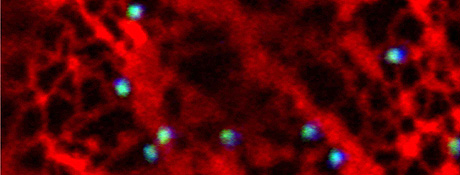New perspectives on the function of the Golgi apparatus
9 August 2012

Picture: Robinson
Cell biologists at the University of Heidelberg have recently obtained data which can explain the different way the Golgi apparatus functions in higher plant and mammalian cells. In contrast to mammalian cells the Golgi apparatus – a membrane system in the cytoplasm, which participates in a variety of metabolic pathways – consists in higher plants of hundreds of small Golgi stacks which move along the endoplasmic reticulum (ER) in a stop-and-go fashion. Prof. David G. Robinson and his research group at the Centre for Organismal Studies of the University of Heidelberg have now been able to provide a mechanistic explanation for the highly ordered and efficient transport of vesicles between the ER and Golgi stacks. Their results have just been published in the journal “Frontiers in Plant Science“.
The Golgi apparatus is one of the most important and variable of the organelles belonging to the endomembrane system. One of its essential functions is to modify and sort macromolecules which are destined for either the lysosome (or the vacuole in plants) of for the extracellular milieu. Whereas in mammalian cells the Golgi apparatus is a complex permanently fixed in the vicinity of the nucleus, in higher plants it is subdivided into hundreds of small mobile Golgi stacks. “A consequence of this morphological difference is that vesicle transport between the ER and the Golgi stacks needs to be highly efficient and strictly regulated in order that vesicles do not get lost during Golgi movement“, explained Prof. Robinson.
In order to investigate this process, the Heidelberg scientists looked for so-called ER-import sites (ERIS): special domains of the ER where incoming vesicles from the Golgi stacks fuse with the ER. “In this regard, one of the most important problems to be addressed was the spatio-temporal relationship of ERIS to the domain(s) of the ER responsible for export (ERES) and to the mobile Golgi stacks“, said Prof. Robinson. In order to identify ERIS, The Heidelberg team used fluorescently-tagged proteins that were known to participate in the process of vesicle fusion. These included so-called tethering factors, responsible for the long-range capture of vesicles, as well as SNARE proteins which are involved in the actual fusion process with the ER membrane.
It turns out that both classes of protein are restricted to domains which lie immediately beneath the the Golgi stacks. “Even more surprising was the discovery that the export domains (ERES) were also present at this position, and that both moved in parallel with the Golgi stacks“, declared Prof. Robinson. By having the import and export machineries so tightly coupled to the Golgi stack, it is now clear how the higher plant cell can effectively accomplish vesicle transfer between the ER and the Golgi apparatus without loss during the fast Golgi movement. “This aspect of the higher plant endomembrane system differs totally from animal cells and is a unique and totally new feature among organisms possessing a nucleus and internal membranes” emphasized Prof. Robinson.
For further information, go to: www.cos.uni-heidelberg.de/index.php/dg.robinson
Note to news desks:
Digital pictures are available from the Press Office.
Original publication:
Lerich A, Hillmer S, Langhans M, Scheuring D, van Bentum P, Robinson DG (2012): ER import sites and their relationship to ER exit sites: a new model for bidirectional ER-Golgi transport in higher plants. Frontiers in Plant Science doi: 10.3389/fpls.2012.00143
Contact:
Prof. Dr. David G. Robinson
Centre for Organismal Studies Heidelberg (COS)
Phone +49 6221 54-6406
david.robinson@cos.uni-heidelberg.de
Communications and Marketing
Press Office
phone: +49 6221 542311
presse@rektorat.uni-heidelberg.de

